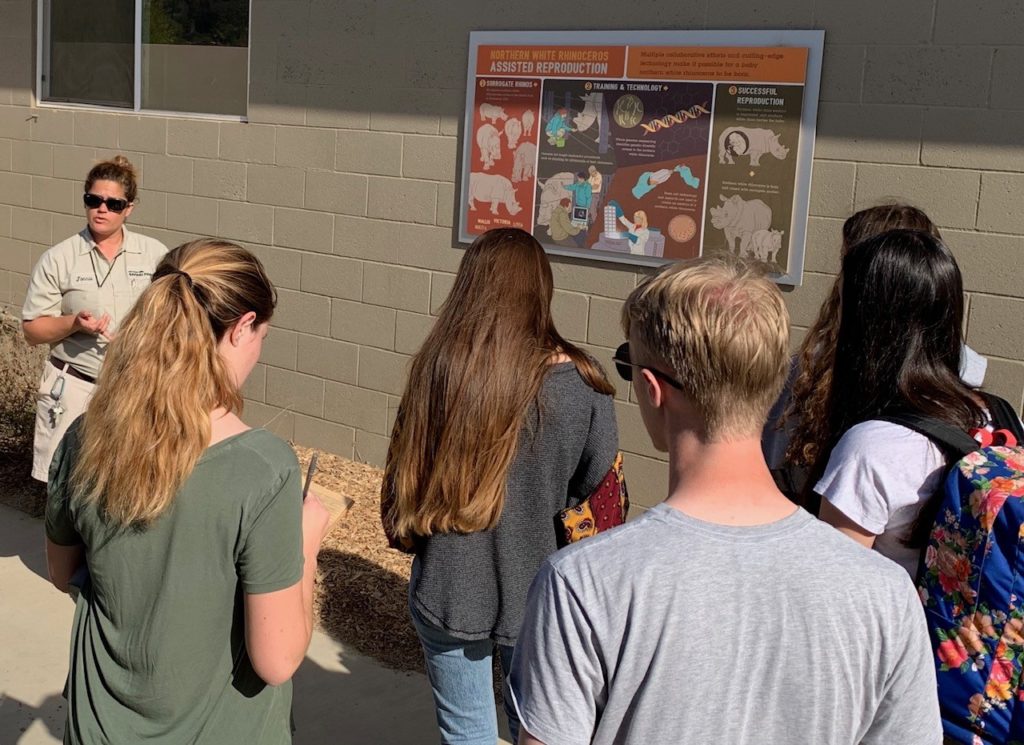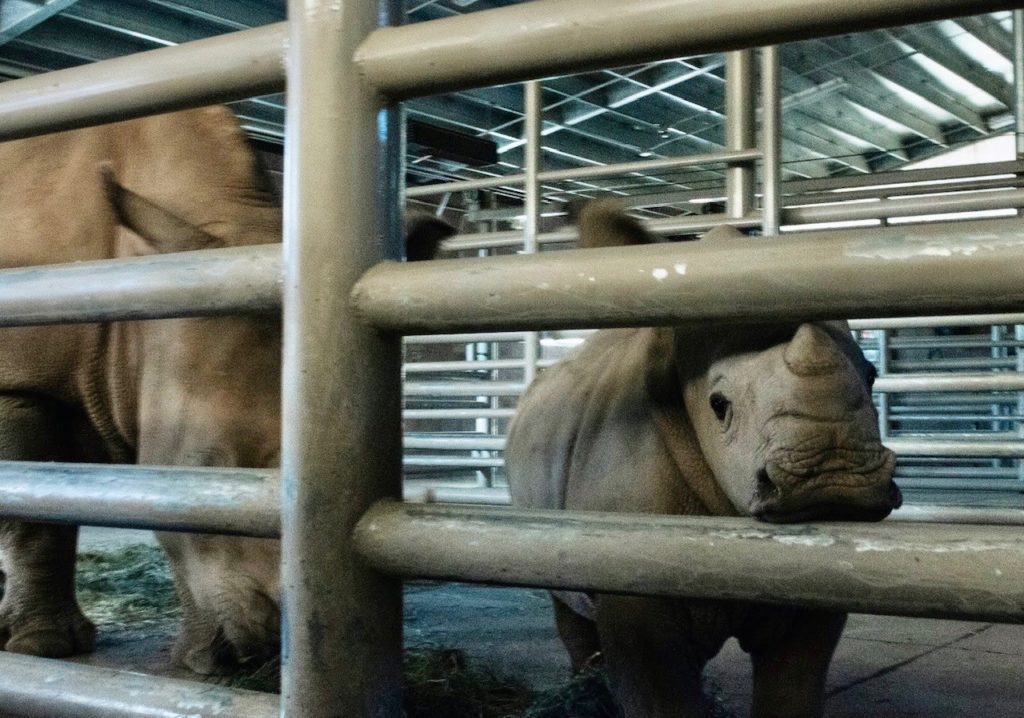
Zoo InternQuest is a seven-week career exploration program for San Diego County high school juniors and seniors. Students have the unique opportunity to meet professionals working for the San Diego Zoo, Safari Park, and Institute for Conservation Research, learn about their jobs, and then blog about their experience online. Follow their adventures here on the Zoo’s website!

Mrs. Capiro next to Edward and Victoria. She stands before this cute pair, after just feeding them treats. Mrs. Capiro has been a part of the incredible journey that these two have been on and she is excited for the future of rhino research.
Working with rhinos everyday can be a handful... A two ton handful of fun! Jonnie Capiro is the Lead Keeper at the Nikita Kahn Rhino Rescue Center (RRC), at the San Diego Zoo Safari Park. The RRC plays a valuable role in saving both the northern and southern white rhinos from extinction. As Lead Keeper, on top of caring for her rhinos, Mrs. Capiro has the responsibility of coordinating the whole team of rhino trainers. Working at the RRC entails anything you can think of including: feeding, breeding, retrieving samples for the reproductive sciences lab, and monitoring behavior. Through positive reinforcement, rhinos have choice and control in their training process. Each primary trainer works with one specific rhino enabling them to get to know the rhino well enough to act as their advocate. Working at the RRC is an amazing experience and allows trainers to build a special bond with all six southern white rhinos in the RRC’s care.

Current home of the rhinos - Nikita, Wallis, and Maoto. These three have gotten along exceptionally well. The structure before them is called a chute and it is used to perform ultrasounds and other medical procedures.
As a primary trainer at the RRC, Mrs. Capiro’s rhino partner is Amani, and she is currently only a few short weeks away from giving birth. At over 5,000 lbs, Amani outweighs Maoto, the RRC’s resident male rhino. As her trainer, it’s Mrs. Capiro’s job to know everything about Amani, so she can make calls about when she can be examined and when she’s feeling too stressed or uncomfortable. Maintaining that trust with every rhino is vital, so the RRC uses positive reinforcement and choice with all the rhinos. By letting them choose to participate in exams and positively rewarding cooperation, they get the best results. Through this bond, the RRC has been able to gather massive amounts of data on southern white rhinos, and take leaps forward in increasing their reproductive success. One of the biggest challenges in Mrs. Capiro’s job is the logistics. Rhinos operate on their own schedules, and even their reproductive cycles can vary wildly. Meanwhile, veterinarians have their days planned to the minute, so it can be challenging when the team misses a rhino ovulation by even a day. Still, every success when dealing with rhinos is another step towards ending extinction.

A major project Mrs. Capiro has been working on is the recovery of northern white rhinos using artificial insemination (a medical procedure that places sperm into the uterus), surrogacy, and other forms of assisted reproduction. Due to poaching and urbanization, there are no longer any male northern white rhinos left in the world. Now there are only two females, a mother and daughter that are past the reproductive age. By using cells collected from 12 northern white rhinos in the past, researchers from San Diego Zoo's Institute for Conservation Research (ICR) plan to create embryos that could be implanted into surrogate southern white rhino females. Since the northern and southern white rhinos are similar subspecies, southern white rhinos have the ability to carry and care for northern white rhino calves. Mrs. Capiro and her team keep track of the rhino’s estrus cycle to alert the veterinary team when they’re ready for insemination. These 12 skin cells from different northern white rhinos might not seem like a lot, but they have more diversity than the entire 20,000 southern white rhino population!

Little Edward peeking through to say hi. Edward is energetic and incredibly loving. He loves to trail behind mom, and mimic her actions. Edward is close to being able to eat solid food, but he is not quite there yet!
However, this is a complicated process and the first step is producing a calf through artificial insemination. Edward the two-month old southern white rhino is currently the only calf at the RRC and the first born through this process in North America. Weighing a whopping 473 pounds, Edward has gained 330 pounds since he was born on July 28th. These rhinos can weigh up to 5,000 pounds as adults. Southern white rhinos are grazers that typically eat grasses and shrubs, but at this age, Edward will continue nursing for the next year before he can eat grass. The southern white rhinos are endangered, with only 20,000 left in the wild due to poaching for their horns, urbanization, and deforestation. Mrs. Capiro noted that one southern white rhino is killed every eight hours. Rhinos help their ecosystem by dispersing seeds and helping maintain plant diversity, but they also have a mutual relationship with oxpeckers which eat bugs from the rhino’s skin. As for what we can do, Mrs. Capiro believes that by educating ourselves and gaining awareness about how we impact the environment, we have the ability to end extinction. Some resources she recommends to learn more about conservation are the International Rhino Foundation, San Diego Zoo Global's Wildlife Conservancy, and the Ol Pejeta Conservancy. We can all be heroes for wildlife by educating ourselves, and making more sustainable, eco-friendly choices.

Speaker Mrs. Capiro giving Edward a scratch. Mrs. Capiro has known Edward since his birth and she has worked at the Nikita Kahn Rhino Rescue Center since its commencement. Edward has recently been working on becoming more independent.
For most of Mrs. Capiro’s life she has loved spending time in the outdoors. Likewise, she dreamed of having a career in something that allowed her to be active and outside, a profession that was rewarding both physically and mentally. She didn’t know what this profession was until college, where she explored different paths, and even had a botany internship. Through this trial and error period, she discovered her passion for wildlife. Straight out of high school she attended Whittier College and got her undergraduate degree in biology, then on to George Mason University to get her Master’s Degree in Interdisciplinary Studies. After graduating, Mrs. Capiro went on to work at the ZooTampa at Lowry Park, the Maryland Zoo in Baltimore, and The Wilds in Ohio before coming to the San Diego Zoo Safari Park. She has now worked at the Safari Park for almost 10 years, and as a keeper for 15 years.
If you are interested in a job like Mrs. Capiro’s, she recommends being positive, dedicated, committed, and flexible. In addition, those who care for the animals must be able to tell when the animal is sick or uncomfortable, and respond to their needs. As for a career path, Mrs. Capiro believes that hard work in college (regardless of where you go) is the key to your success. She also recommends getting involved in volunteer work and internships to meet those who work in the field.

The interns and Mrs. Capiro in front of Victoria and Edward. Interns got to see the love between a mother and her child, and they also got to meet North America’s first artificially inseminated baby southern white rhino.
We are all so grateful to have gotten the opportunity to learn more about these majestic creatures, how we can help conservation efforts, and new career paths. It was also touching to hear about the close bond and respect between rhino and trainer. The RRC has a great mission of rebuilding the northern white rhino population. San Diego Zoo Global has done a remarkable job in caring for and conserving rhinos, and Edward is obviously proof. Thanks to the RRC, the future for endangered rhino species and especially the future of the northern white rhino looks much brighter.
Week Two
Fall Session 2019




